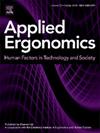Operational performance, cognitive load, visual attention, and usability of fixed-, manual-, and autonomous-camera control in single- and multiple-camera telemanipulation systems
IF 3.4
2区 工程技术
Q2 ENGINEERING, INDUSTRIAL
引用次数: 0
Abstract
Camera control is crucial in telemanipulation, yet its effects on human operators remain underexplored. This study examined five camera viewpoint control models in a telemanipulated cube-stacking task involving 35 participants: (1) three fixed cameras; (2) two fixed cameras plus one dynamic camera with autonomous viewpoint control; (3) two fixed cameras plus one dynamic camera with manual viewpoint control; (4) a single dynamic camera with autonomous control; and (5) a single dynamic camera with manual control. We evaluated performance (cube-stacking success rate and completion time), cognitive load (eye-tracking measures of blink rate and pupillary activity, and perceived workload), visual attention (eye-tracking measures of fixation and saccade rates), and usability. Multiple-camera models improved task success but increased cognitive load (lower blink rates and higher pupillary activity) and saccade rates. Between multiple-camera models, autonomous-camera models showed lower saccade rates. Dynamic-camera models were rated more usable than fixed cameras. These findings reveal key trade-offs in camera control design and guide the creation of more efficient, operator-friendly telemanipulation systems.
操作性能,认知负荷,视觉注意力,和可用性的固定,手动和自主相机控制在单和多相机遥控系统
相机控制在远程操作中是至关重要的,但它对人类操作员的影响仍未得到充分的研究。本研究考察了35名被试在远程操作立方体堆叠任务中的5种摄像机视点控制模型:(1)3台固定摄像机;(2) 2台固定摄像机+ 1台具有自主视点控制功能的动态摄像机;(3) 2台固定摄像机+ 1台手动视点控制动态摄像机;(4)具有自主控制功能的单个动态摄像机;(5)单个手动控制动态摄像机。我们评估了他们的表现(立方体堆叠成功率和完成时间)、认知负荷(眨眼率和瞳孔活动的眼动追踪测量,以及感知的工作量)、视觉注意力(注视和扫视率的眼动追踪测量)和可用性。多摄像头模型提高了任务的成功率,但增加了认知负荷(更低的眨眼频率和更高的瞳孔活动)和扫视率。在多摄像头模型中,自主摄像头模型的扫视率较低。动态相机模型被认为比固定相机更有用。这些发现揭示了相机控制设计中的关键权衡,并指导了更高效,操作员友好的远程操作系统的创建。
本文章由计算机程序翻译,如有差异,请以英文原文为准。
求助全文
约1分钟内获得全文
求助全文
来源期刊

Applied Ergonomics
工程技术-工程:工业
CiteScore
7.50
自引率
9.40%
发文量
248
审稿时长
53 days
期刊介绍:
Applied Ergonomics is aimed at ergonomists and all those interested in applying ergonomics/human factors in the design, planning and management of technical and social systems at work or leisure. Readership is truly international with subscribers in over 50 countries. Professionals for whom Applied Ergonomics is of interest include: ergonomists, designers, industrial engineers, health and safety specialists, systems engineers, design engineers, organizational psychologists, occupational health specialists and human-computer interaction specialists.
 求助内容:
求助内容: 应助结果提醒方式:
应助结果提醒方式:


